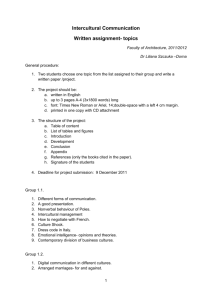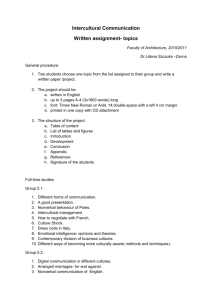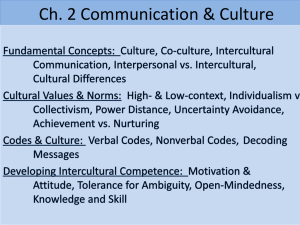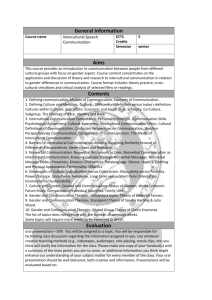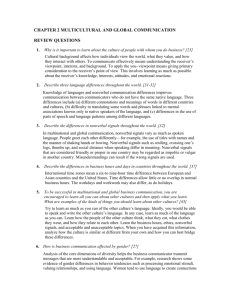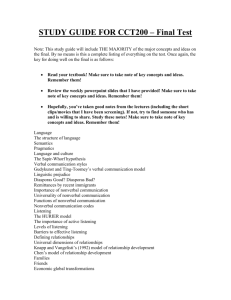Communication Written assignment- topics Faculty of Architecture
advertisement
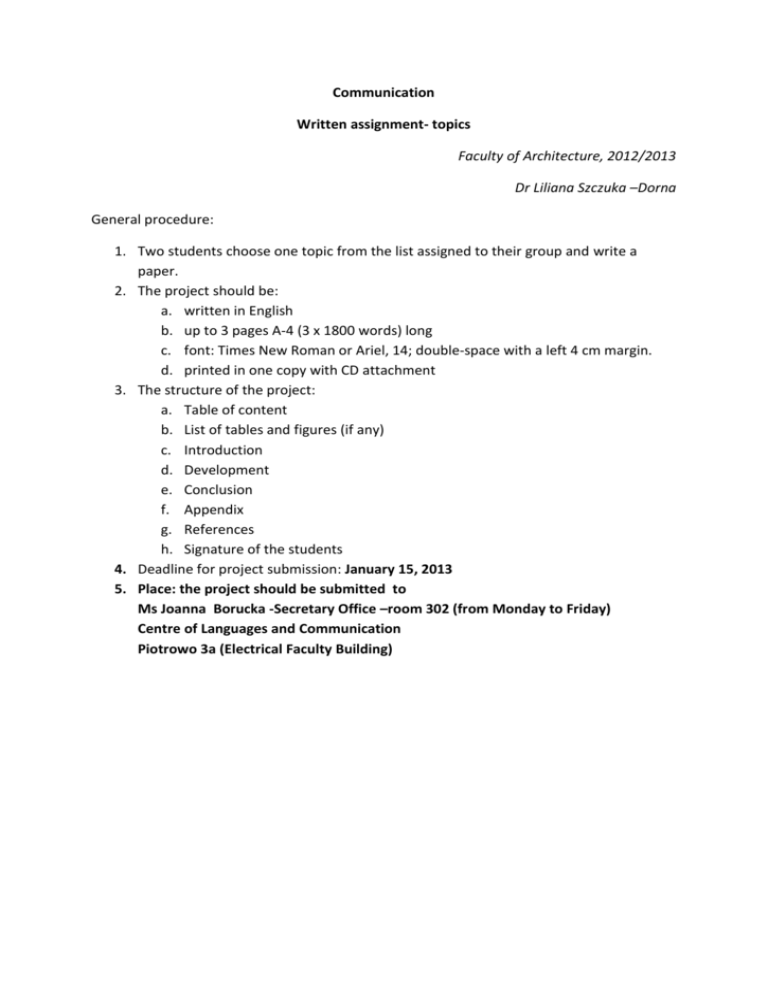
Communication Written assignment- topics Faculty of Architecture, 2012/2013 Dr Liliana Szczuka –Dorna General procedure: 1. Two students choose one topic from the list assigned to their group and write a paper. 2. The project should be: a. written in English b. up to 3 pages A-4 (3 x 1800 words) long c. font: Times New Roman or Ariel, 14; double-space with a left 4 cm margin. d. printed in one copy with CD attachment 3. The structure of the project: a. Table of content b. List of tables and figures (if any) c. Introduction d. Development e. Conclusion f. Appendix g. References h. Signature of the students 4. Deadline for project submission: January 15, 2013 5. Place: the project should be submitted to Ms Joanna Borucka -Secretary Office –room 302 (from Monday to Friday) Centre of Languages and Communication Piotrowo 3a (Electrical Faculty Building) Topics: Group 1.1. 1. 2. 3. 4. 5. 6. 7. 8. 9. Different forms of communication. A good presentation. Nonverbal behaviour of Poles. Intercultural management How to negotiate with French. Culture Shock. Dress code in Italy. Emotional intelligence- opinions and theories. Contemporary division of business cultures. Group 1.2. 1. 2. 3. 4. 5. 6. 7. Digital communication in different cultures. Arranged marriages- for and against. Nonverbal communication of English. How to negotiate with Germans. Dress code in China. How to solve intercultural conflicts. How to organize brunch and gala dinner. Group 1.3. 1. 2. 3. 4. 5. 6. 7. 8. Nonverbal communication in Spain. Exchanging business cards in different cultures. Different forms of business small talk. English as lingua franca. American management practices. Kisses and hugs in formal meetings in different cultures. How to improve writing skills. Dress code in India. Group 1.4. 1. 2. 3. 4. 5. 6. 7. 8. 9. How to organize wine reception and lunch. How to improve speaking skills. Nonverbal behaviour of Greeks. Stereotypes and their role in communication. How to negotiate with Russians. French management practices. Dress code in Poland and Japan- differences and similarities. The role of a leader in contemporary organization. Gestures- for and against their use in business. Group 1.5. 1. 2. 3. 4. 5. 6. 7. 8. 9. Nonverbal behaviour of Scandinavian cultures. Dress code in America. Ice-breakers: how to start a meeting with strangers. Physical appearance: creating good impression during meetings. Individualism and collectivism. Politeness in Poland and Japan- comparison. Do’s and taboos of Polish culture. Power distance in different cultures. Doing business in Netherlands. Group 1.6. 1. 2. 3. 4. 5. 6. 7. 8. 9. Nonverbal behaviour of a selected culture. Proxemics in different cultures. Benefits of intercultural communication knowledge. The role of cultural differences in contemporary world. Japanese housing. Dress code in France and Italy. Do’s and taboos of American culture. Empathy in two selected cultures. Sex and gender roles in Japan and Saudi Arabia. Group 1.7. 1. 2. 3. 4. 5. 6. 7. 8. 9. Dress code in a selected culture. Business etiquette. How to improve listening skills. Bribes - to give or not to give. What international students should know about Polish culture. Norwegian management practices. The meaning of silence in business meetings. Business correspondence- different forms. Nonverbal behaviour of Canadian. Group 1.8. 1. 2. 3. 4. 5. 6. 7. 8. 9. Presents during official meetings. Dress code in Greece. Edward Hall and his division of cultures. Definitions of nonverbal communication. How to negotiate with Arabs. How to improve negotiating skills. Gender stereotypes in two selected cultures. Giving a talk- important elements of public speaking. Culture shock in Poland- how to help foreigners in our country. Group 1.9. 1. 2. 3. 4. 5. 6. 7. 8. Different ways of becoming more culturally aware ( methods and techniques). How to write a good report. R. Covey-his theory i.e. 8 habits of effective life. Do we need Power Point presentations? Code of ethics in contemporary business- examples. Presents in the business world- for and against. Intercultural organizations- examples and best practice. Intercultural Communication on the web pages- a resource file. Group 1.10. 1. 2. 3. 4. 5. 6. 7. 8. Describe one European culture. Nonverbal communication at university. G. Hofstede and his index of cultures. Describe one element of nonverbal communication. Good presentation skills- theory and examples. Negotiation skills of Germans. How to empathize with Poles. Different ways of running a meeting-useful hints. Group 1.11. 1. 2. 3. 4. 5. 6. 7. 8. Negotiation skills of Poles. Small talk in different cultures. An ideal public speaker. Edward Hall and his theories. What is important in negotiations? Written elements of formal English needed at work. Gestures have different meanings. How to solve intercultural conflicts. Group : English 1. 2. 3. 4. 5. 6. 7. 8. 9. Negotiation skills of Russians. Nonverbal communication of English. How to negotiate with Germans. Dress code in China. Gender stereotypes in two selected cultures. Giving a talk- important elements of public speaking Business etiquette. How to improve listening skills. How to negotiate with different cultures.
